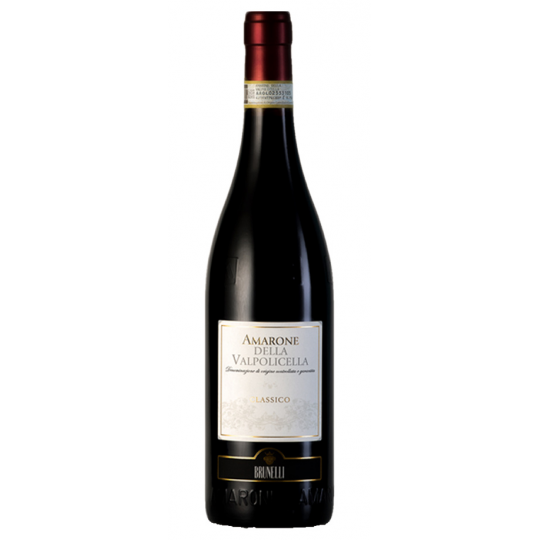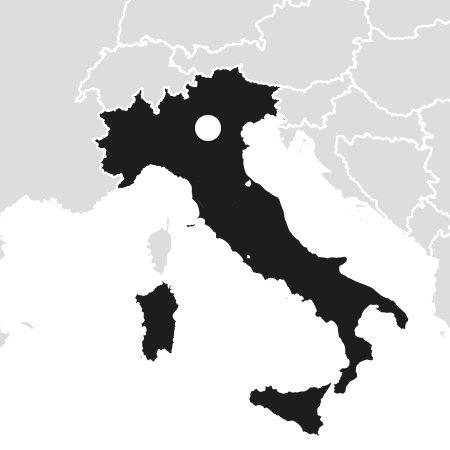Waarom deze wijn?
Een heerlijk pure en zuivere Amarone van vooraanstaand Amarone-huis Brunelli. Vol van smaak met ronde en fluweelzachte tannines en een lange afdronk. Je kunt er nu al van genieten maar kan ook makkeijk nog een paar jaar liggen.
De smaak
Brunelli's Amarone Classico heeft een intense robijnrode kleur en, in de neus, zoete fruitige tonen, rode bessen, bosbessen en kersen en een karakteristiek vleugje vanille van de eiken vaten. De smaak is majestueus, zachte, verwarmende sensaties worden gecompenseerd door een goede zuurgraad en zachte tannines die een bevredigend evenwicht creëren. Dit is een elegante wijn met een benijdenswaardige en opmerkelijke structuur.
De details
type wijn: full bodied, intens, rijk en elegant
druivensoort: Corvina Veronese 65%, Rondinella 25%, Corvinone 10%
teelt: conventioneel
opvoeding : 24 barriques en in Sloveense hout, 6 maanden op fles
alcoholgehalte: 15,00 % vol.
afsluiting: natuur kurk
drinktemperatuur: 18-20 graden
bewaarpotentieel: 2020 - 2033
Spijs-aanbeveling
Qua keuken denk je in eerste instantie aan vlees, maar vergis je niet. Harrie Baas, voorheen van sterrenrestaurant Amarone in Rotterdam, maakt fantastische combinaties met gebakken kabeljauw en een jus met ingekookte wijn. Of bij lam uit de oven, osso bucco, lasagna, geouderde kazen of pasta met lamsragout.
De prijzen elders?
Wij vergelijken het voordeel altijd met de prijzen in de online-markt. Belangrijk is dat er dan wel 'appels met appels' worden vergeleken; dus precies dezelfde wijn per 6 flessen van (bij voorkeur) hetzelfde jaar èn bij jou thuisbezorgd (de bezorgtarieven elders zijn meegenomen in de prijscheck).
De oorsprong
De familie Brunelli maakt fluweelzachte Amarone. Van de imposante Robert Parker tot de eigenzinnige Ian d’Agata, iedereen vindt ze geweldig. Al sinds de 18e eeuw maakt de familie wijn in het hart van Valpolicella, San Pietro in Cariano. Vlak bij het Gardameer. Zoals ze zelf zeggen maken ze wijnen ‘that are incomparable examples of their terroir: original products that are highly recognizable and distinguishable’. Traditie gaat hier hand in hand met avantgarde vinificatie. Het resultaat mag er zijn; onderscheidende, grootse Amarones.
Slimme weetjes: Het ontstaan van Amarone
Bolla was one of the first producers to commercially market an Amarone wine from Valpolicella. While the style of Amarone has existed in the region for centuries, it was very rarely made as a deliberate wine style. Mostly it was produced in warm vintages when batches of wines destined for sweet recioto were unintentionally allowed to ferment completely dry. The modern concept of Amarone has its roots in the early 1950s when producers "rediscovered" the style and began deliberately using yeast strains that could ferment the high levels of sugars in the wine completely into alcohol.
The first completely dry Amarones that were commercially marketed were the 1953 vintages produced by Bolla and Bertani. In 2009, the production of Amarone wine in the Valpolicella zone achieved DOCG status. During the petitioning process, the wine producers in the region established several quality control regulations including quotas on the amount of grapes grown in the fertile plains that could be used in Amarone production. Another measure was the 2003 removal of Molinara from the list of mandatory blending grapes. Amarone is unique in the wine world. Typically very alcoholic, full-bodied and ripe-tasting wines are produced in very warm climate regions, where the grapes are able to build up large amounts of sugar while ripening on the vine. Examples of warm climate regions include parts of Australia, California and southern Italy.
Slimme weetjes: Alleen in Valpolicella zo bijzonder
The Valpolicella region is characterized as a "cool climate region" where acid levels are usually maintained and sugar build occurs more slowly in the vine. Grapes destined for Amarone are the last grapes in Valpolicella to be harvested, getting as ripe as they can before mold and rot set in. The sugars in the grapes are then concentrated by a process of desiccation where they are kept in special drying rooms for anywhere from three to four months. During this time over a third of the water is removed as the grapes shrivel into raisins. This method (known as passito) produces more concentrated grapes that still maintain the acid balance of a cool-climate grape.
Amarones differ from other late harvest wines in that the presence of Botrytis cinerea is actively discouraged, as winemakers attempt to avoid the smoky, mouldy flavors that come with botrytized wine. Extra care is taken in the vineyard to ensure that the grapes are kept dry and harvested before rot can develop.
Slimme weetjes: het zorgvuldige rijpingsproces van Amarone
The Amarones are then aged for several years, with many premium examples being aged for at least five years prior to release. They are often aged in large wooden barrels of either Slavonian or French oak. Traditionally the barrels are older and essentially "neutral", in that they do not impart much flavor or wood tannins, but in the late 20th and early 21st centuries more Amarone producers have been experimenting with the use of smaller new oak barrels that introduce more oak flavoring to the wine.
Slimme weetjes: Amarone en spijzen
Amarones are rich, full-bodied wines with flavor and aroma notes that are often compared to the flavors of Port wine. The wines often have notes of mocha, bitter-sweet dark chocolate, raisin, dried fig and earthy flavors. At restaurants sommeliers will often recommend food and wine pairings for Amarone with hearty, heavy dishes such as meat roasts. A classic after-dinner assortment is Amarone paired with walnuts and Parmigiano-Reggiano cheese. Master of wine Mary Ewing-Mulligan notes that well-made examples of Amarone from favorable vintages usually need about ten years of bottle aging for the flavors to mature, and have the potential to continue developing for twenty years or more.
From Wikipedia, the free encyclopedia.


